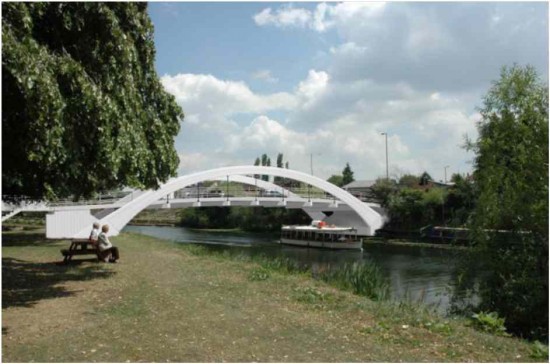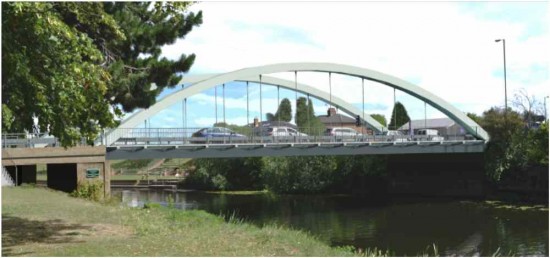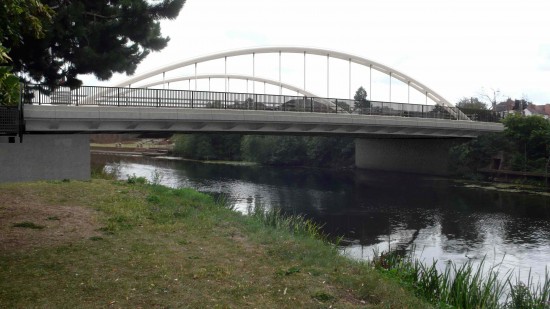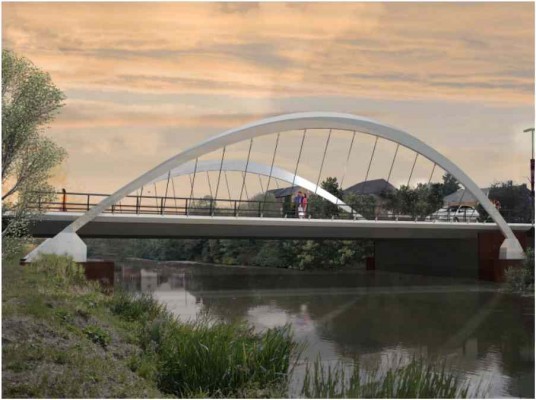Update: I’ve edited this article as I originally got the images of the bridges incorrectly assigned to their respective designers.
As anyone who lives in or near Evesham will know, the Abbey Bridge is going to be replaced over the course of the next year or so because the current one is gradually falling to pieces. The chosen design was revealed a couple of months ago, along with a consultation on plans to manage traffic during the period when the bridge is closed. But until now, we didn’t know what the other options were that weren’t chosen.
I’m a regular user of the WhatDoTheyKnow website, and I have it set to automatically email me whenever someone uses it to put in an FOI request to one of our local authorities. So when I got an email telling me that there was a request related to the bridge design, I made a point of keeping an eye on it. The request was recently answered. So we can now see which other designs were proposed for the bridge, and, possibly more interestingly, why the decision was made to choose the one which will be built.
There were five bidders for the bridge, and they each produced their own design. Interestingly, all the designs were very similar – I was rather disappointed that nobody had come up with something particularly left field, but, on the other hand, the fact that they do all look much the same means that there’s nothing controversial about the one which got the nod. Here are the five bridges:
The last image is the one which was chosen, as you’ll recognise if you’ve seen the media reports.
As you can see, they’re all essentially a simple arch design similar to the existing bridge. The Balfour Beatty design is probably the most distinctive, having the arches seemingly at an angle rather than upright, while the Alun Griffiths design seems to go for lighter and more elegant arches than the others. But there really isn’t a lot in it. The panel convened to assess the aesthetic appeal of the different options went for the Balfour Beatty design.
So, why was the Hochtief design chosen?
Well, in the end the answer was simple – it was the cheapest. In fact, it was the cheapest by a big margin – the next cheapest, the Dawnus proposal, was nearly twice as much. It’s also the one which has the lowest ongoing maintenance cost, and on the panel evaluation – which covered things like risk assessment, quality control, etc – it scored 7 out of 10 with only Alun Griffiths doing better on 8 (and only Balfour Beatty doing worse on 6). So as decisions go, it was probably pretty much a no-brainer for the council’s Highways department – it would have taken a very strong justification indeed to have selected one of the other bidders.
The one aspect that may possibly prove controversial, though, is the closure period. The winning Hochtief bid requires a full closure of the bridge for 48 days, which is pretty close to the 42 days in the Balfour Beatty proposal. The BAM Nuttall bid would have seen the bridge closed for a whopping 203 days, which is clearly unacceptable – it’s a good job that they were expensive enough that that wasn’t a viable option anyway! But both the Alun Griffiths and Dawnus bids included a closure period of precisely zero days. That is, they were planning to keep traffic flowing, at least in restricted form, throughout the entire construction period.
How they planned to do that I don’t know, since I haven’t seen the full tender documents. My guess is that they either planned to use a temporary structure, or to build the new bridge deck underneath or above the existing deck and then remove the old one once the new one was in place. But, however they were planning to do it, I’m sure some Evesham residents will argue that, even if the cost was higher, it was worth doing.
My own opinion, for what it’s worth, is that it probably wouldn’t have been justified anyway. It’s quite possible that a quid pro quo of a non-existent total closure is a much longer period of partial closure with temporary traffic lights and reduced width. Imagine nearly a year of, say, just one lane open across the bridge with four-way traffic lights at the Cheltenham Road junction and queues backing up up to the bypass. I’d rather keep the bridge itself, and the junction, fully open for as long as possible and do the main replacement in one fell swoop with a short period of total closure.
Anyway, I like the Hochtief design. It has the important advantage, for me, that the pedestrian walkways are outside the arches instead of inside them as on the Balfour Beatty and Dawnus designs (as well as the current bridge). Putting the walkways outside the arches will make it a much more pleasant bridge to cross on foot, as there will be a physical barrier between you and the traffic – something which is particularly important if you have small children with you. And, whatever we’re getting, I’m glad we’re getting a new bridge. The alternative would have been almost unthinkable.





